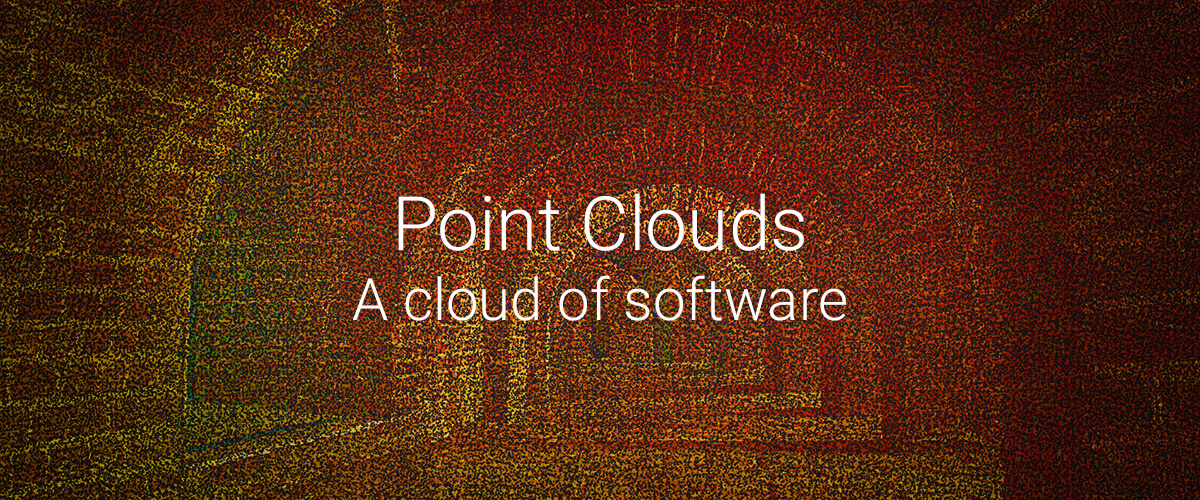The following is an overview of useful software tools to allow you to use and manipulate the point cloud data once it has been created. This overview is far from complete because there are just too many to mention them all. This fourth post will talk about:
- Commercial desktop software
- Different software license types
- Free desktop software
- Useful free libraries
- Web viewers
- Free sources of online point cloud data
Commercial desktop software
Data would be nothing without the appropriate software to process it. Many software solutions for point clouds exist. Most of these also have a free viewer mode. This is an overview of the most important ones:
- FARO SCENE and Virtusurv and free viewer Scene LT.
- Leica CloudWorx suite has plugins for AutoCAD, Revit, and BricsCAD. Leica Cyclone also has a license-free viewer mode.
- Trimble Realworks (free Trimble Realworks viewer).
- Bentley Pointools (free Bentley Pointools View.
- PointCab vectorization possible, mainly based on 2D orthographic projections and slices.
- PointFuse creates meshes from point clouds, followed by intelligent segmentation and object recognition.
- EdgeWise extracts geometries semi-automatically and exports them into CAD files.
- ImaginIt semi-automatic creation of geometries in a CAD environment.
- GeoPlus VisionLidar can visualize, process, classify, segment, animate, and edit.
- MARS: supports both airborne and terrestrial laser scanning, with many import, analyse and export functions (also has free viewer mode).
- Elysium InfiPoints handles the work flow, from importing data to filtering, registration to analyzing CAD geometries and even, exporting.
- 3DReshaper can import, analyze/reverse engineer/model and export. Also has subproducts, like Meteor (metrology) and an SDK with interfaces in C++ and Javascript. A free viewer is also available.
- Capturing Reality manage and merge datasets from different sources (laser scanners, drones, photographs, etc.) into a single detailed model.
- Quick Terrain Modeler: for visualization and analysis of terrain models. Also has free viewer called Quick Terrain Reader.
- Fugro viewer another free viewer for geospatial data including point clouds.
Software license types
- Commercial licenses mean that clients must buy a license to use software and cannot further distribute the software. This is probably the best-known software license that customers come across when buying software. Typical examples are Microsoft Windows and Adobe Photoshop.
- Different types of free licenses:
- Certain licenses give you permission to use the software in any way you want (like use in commercial software products), as long as you include the original copyright notice of the software. Examples of such licenses are MIT and BSD. For commercial use, this is the least restrictive type of license.
- Another type of license GPL, which states that all software that uses some part of it falls under the GPL and must also be released under the GPL. For commercial companies, this is the most restrictive license. Strictly, software as a service does not fall under GPL. However, the more recent AGPL does cover this type of usage explicitly.
- There are also licenses that are a bit of a compromise between the two extremes, like the LGPL. This says that all changes made to the LGPL product itself must also be released again and include a copyright notice but other software can use it, even for commercial use.
Free desktop software
There are also two extremely useful entirely free/open source standalone programs for point clouds:
- Meshlab is an open source (GPL) software package for processing and editing meshes. However, it also supports several point cloud formats. This program is good for quick visualizations of point clouds. It can show different data files and let the user show/hide different files. Also, when importing both point cloud files and meshes (e.g., ply files), it is a nice tool to compare the point clouds with the meshes. Furthermore, it allows a user to edit point clouds (remove points for example) and also to create meshes from point clouds.
- CloudCompare is another free/open source (LGPL core, rest GPL) 3D point cloud and mesh processing software. This program is actually dedicated to point clouds and has a big set of algorithms for shape extraction, point clustering/segmentation, registration, etc.
Useful libraries
Software is not always written just for end users. Some companies decide to distribute libraries, so that other companies then can integrate them into their own products. An example of a commercial point cloud library that can be integrated in other products is:
Next to commercial libraries, there are also free point cloud libraries. The two best known free libraries are:
- Point Cloud Library (PCL, under 3-clause BSD license) is a standalone, large scale, open project for 2D/3D image and point cloud processing (C++, with Python bindings available). It contains a large set of state-of-the-art algorithms for filtering, computation of point descriptors, surface reconstruction, registration, model fitting, and segmentation. PCL can be used both in commercial and non-commercial products. Furthermore, this project has a large support community (both in terms of contributing developers and financial support).
- Point Data Abstraction Layer (PDAL, BSD license) allows you to compose operations on point clouds into flows of different processing steps.
Web viewers
Sometimes, full functionality is not needed and a web-based viewer is sufficient. In that case, it is worth having a look at the following projects:
- Potree and source on GitHub: an academic research project by Markus Schuetz, which is available for third-party usage under an MIT-like license.
- Plas.io and source on GitHub, a project by Uday Verma and Howard Butler, also available for third-party usage under MIT license.
- Point Cloud Web Viewer is a webpage based on Three.js to visualize point clouds (BSD license). View a demo here.
- Flyvast: a commercial web-based point cloud software suite, not just for viewing but also management, measurements, analysis, etc.
- LidarView by XtSense GmbH, a free, simple and useful way of viewing point cloud data in a browser.
Free point cloud data online
For people who want to get started with point clouds, here are some links to online, publicly available datasets:
- DURAARK project: a unique collection of datasets from the architectural domain, with point clouds and reference, ground, IFC models
- Top 6 free lidar data sources (USA geography)
- Lidar Point Cloud -- USGS National Map 3DEP Downloadable Data Collection
- ETHZ sample data
- E57 sample data
- Geo data (also Lidar) from The Netherlands
- Repository with benchmark data from Ph.D. thesis of Charles Thomson
- Leica BLK360 sample scans
Ready to try BricsCAD
Easy to try, easy to buy, easy to own. That's BricsCAD. Try all of our products, for free for 30 days. Freedom of choice, plus perpetual (permanent) product licenses that work with all languages, in all places. You'll love what we've built for you with the BricsCAD product family.
Keep Reading
- What's the point?
- Pointless without scanners
- Avoid cloudy expectations during a scanning project
- A cloud of software
- On point performance
- Scan-to-BIM
All brand names and product names mentioned in this post are trademarks or service marks of their respective companies.

